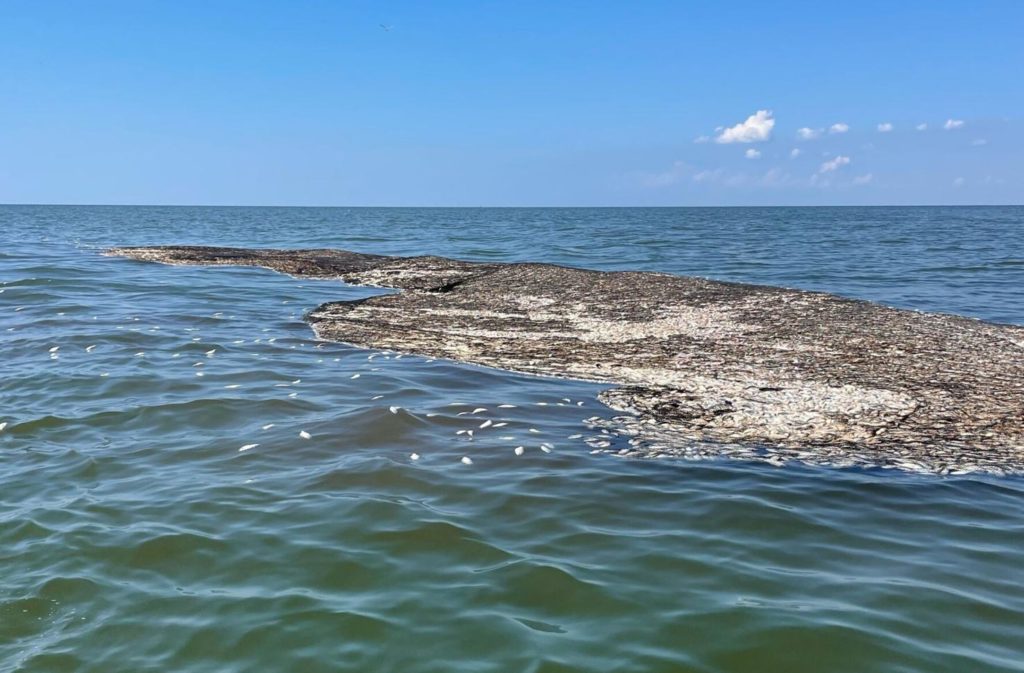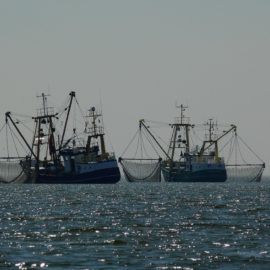
Courtesy of Hackberry Rod and Gun
The menhaden industry is poorly regulated in Louisiana where it is more regulated in the adjoining states.
A menhaden fishing boat overwhelmed by an unexpectedly big catch let loose a massive raft of dead fish off the coast of southwest Louisiana last week, sparking outrage from conservation groups and renewed calls for tougher rules governing the state’s largest but least-regulated fishery. Omega Protein estimates it lost about 900,000 menhaden when one of its crews cut free a bulging net less than a mile from Holly Beach in Cameron Parish on September 8. Dead fish formed a rotting mass over the weekend, drawing complaints from several charter boat captains, which target the redfish and other species that depend on menhaden for food. “It’s hard not to be disgusted when you see that,” said Chris Macaluso, marine fisheries director for the Theodore Roosevelt Conservation Partnership. “It seems excessively wasteful to catch that much fish, and it’s just left there. There should be some sort of penalty.”
nola.com
The Department of Wildlife and Fisheries is not concerned.
The incident elicited shrugs from the state Department of Wildlife and Fisheries. Jason Adriance, one of the agency’s fisheries managers, said only about 2% of the Gulf of Mexico’s menhaden stock is fished each year, so Omega Protein’s mishap doesn’t matter much. “A couple million extra is insignificant,” Adriance said. Also called pogy and fatback, menhaden are by far the state’s largest fishery, generating between 600 million and 900 million pounds for the two foreign-owned menhaden fishing companies that operate in Louisiana. Most of the dollar bill-sized fish are ground up into fertilizer, pet food and fish oil supplements.
Menhaden are in the food chain of many fish and the fishing methods catch many other species of fish.
Menhaden are part of the foundation of the marine food web, providing a fat-rich energy source for marine mammals, fish and birds. Conservation and recreational fishing groups are concerned that the largely unchecked fishery is taking food from other species like speckled trout and dolphins, which have suffered population declines in recent years. They note that all other Gulf states either prohibit menhaden fishing or have such strict rules that the industry now focuses entirely on Louisiana waters. Menhaden nets often catch more than menhaden, making the lost net an ecological concern, said Ben Graham, chairman of Wildlife and Fisheries’ Finfish Task Force, which has been critical of the agency’s menhaden policies. “Lots of other fish try to catch menhaden and get caught in these nets,” Graham said. “So we have this net out there doing a constant cycle of killing.”
A charter boat found the net but it appears to be lost now as it can’t be found.
A charter boat captain found the 1,500-foot-long net and reported it but search crews sent by Omega and Wildlife and Fisheries haven’t been able to locate it. The menhaden fishing boat was a victim of its own success, said Omega spokesman Ben Landry. “We’ve been experiencing some really, really big schools down in southwest Louisiana,” he said. “The captain thought he brought back 500,000 pounds. Turns out it was a lot more than that. ”The net was so overloaded that a larger “mothership” could not safely get the fish aboard. The captain ordered the net cut free just before it ripped open and drifted away. “He knew he’d lose the net because it had gotten too heavy,” Landry said. “Then the weight of the fish ripped the net.” Having to cut a net is rare, but large net tears happen two to three times a year, Landry said. Much of the catch appears to have died while caught in the net. Anglers spotted a large amount of bycatch, including redfish, floating belly up amid the the menhaden. Photos of the dead fish began making the rounds with recreational fishing groups this week. “We must continue to shine a light on this industry and the damage being caused to our fisheries, our coastal wildlife, and our critical habitats,” the Coastal Conservation Association of Louisiana wrote in an email to members on Wednesday.
Menhaden restrictions just came in recently and before there were few.
Louisiana’s first substantial restrictions on the fishery went into effect this summer. Menhaden vessels must stay a quarter mile from much of the coast, with larger buffers around Elmer’s Island, Grand Isle, and Grand Terre Island. But, as conservation groups note, the rules fall far short of other Gulf states. A bill that would have placed the state’s first catch limits on menhaden was blocked by a state Senate committee in May. The industry’s backers say a catch limit could kill the industry and cost Louisiana several hundred jobs. But the economic benefits have come at a price. Plaquemines health officials and environmental groups have been raising alarms about Daybrook Fisheries’ menhaden processing plant in Empire for decades. The plant’s own safety manager filed a lawsuit in March alleging that the plant willfully spews large amounts of fish waste into the Mississippi River and other nearby waterways, and has resisted taking basic precautions to avoid spills. Omega’s Abbeville plant has been the source of odor complaints from towns more than 20 miles away. Among its environmental violations was a $1 million fine in 2017 for twice dumping large volumes of polluted water into the Vermilion River. In 2019, Omega agreed to pay $1 million to resolve allegations that the company obtained a government loan by falsely certifying compliance with clean water laws.
This event was unfortunate.
Landry said last week’s dumping of nearly a million fish was “an unfortunate situation” the company hopes to avoid repeating. “We take this seriously, and we’ll look at our procedures,” he said. “But with a population in the hundreds of billions, losing this number of fish is not anything to give people a fear that there’s a problem with the stock.”
With few restrictions the industry can act with impunity.



